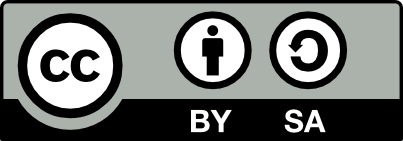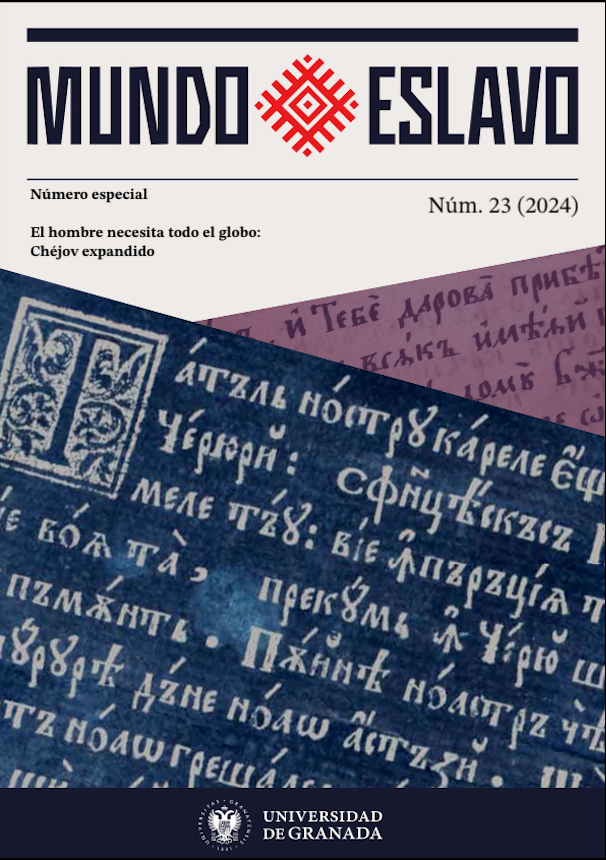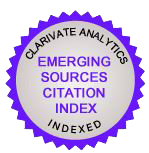Parallels of the Sharp Ironic Style of O. I. Senkovsky’s Prose in A. P. Chekhov’s Work
DOI:
https://doi.org/10.30827/meslav.1.31475Keywords:
Chekhov, What is most often found in novels, novellas, etc.?, Senkovsky, Autumn Boredom, irony, cliché, thematic similaritiesAbstract
The present article is a search for thematic and stylistic interrelations between A. P. Chekhov's story ‘What is most often found in novels, novellas, etc.?’ and O. I. Senkovsky's story ‘Autumn Boredom’, published almost half a century earlier. Senkovsky, ironising over the tendencies fashionable in the first third of the 19th century in social life and literature influencing it, in a sufficiently developed form elevates them to an absolute and thus openly condemns them. A. P. Chekhov, in a much more concise form, essentially only listing what to him appear to be the recurrent strains of literary works of the last third of the 19th century, achieves the same satirical and ironising tone of the work itself. The stories, which differ sharply from each other in style, however, point to a large extent to the same phenomena, which do not seem to have disappeared, but still have their place in Chekhov's contemporary literature. Both works share the writers' common ground in their view of the unproductive strains of contemporary literature and are an interesting testimony to the ironic-critical beginning of their talent.
Downloads
References
Chapaeva, L. G. (2017). Spory o mestoimenijach sej i onyj kak fakt istorii russkoj kul’tury i literaturnogo jazyka XVIII-XIX vv. (Disputes about Pronouns сей and оный as a Fact of the History of Russian Culture and Literary Language of the XVIII-XIX Centuries). V: Slovĕne, 6, Nr. 2, 347–364.
Chekhov, A. P. (1983). Chto chashche vsego vstrechajetsja v romanach, povestjach i t. p.? (What is Most Often Found in Novels, Novellas, etc.?)V: Chekhov, A. P. (1983). Polnoje sobranije sochinenij i pisem. V tridcati tomach. Sochinenija v vosemnadcati tomach. Tom pervyj 1880–1882 (Complete Works and Letters. In Thirty Volumes. Works in Eighteen Volumes. Volume One 1880–1882). Moskva: Nauka, 17–18.
Drozda, M. (1990). Narativní masky ruské prózy. Od Puškina k Bělému (Kapitoly z historické poetiky). [Narrative Masks of Russian Prose. From Pushkin to Bely (Chapters in Historical Poetics)]. Praha: Univerzita Karlova.
Kubasov, A. V. (2024). Iskusstvo parodijnoj stilizacii kak odna iz strategij tvorchestva A. P. Chekhova (rasskaz «Krivoje zerkalo»). [The Art of Parodic Stylisation as One of the Strategies of A. P. Chekhov’s Creativity (The Story ‘Crooked Mirror’)]. V: Kubasov, A. V. Proza A. P. Chekhova: ot teksta k kontekstu i intertekstu(Chekhov‘s Prose: From Text to Context and Intertext). Jekaterinburg: Ural’skij gosudarstvennyj pedagogicheskij universitet, 92–99.
Os’muchina, O. Ju. (2011). Prelomlenije tradicii avtorskoj maski v russkoj proze 1830-ch gg. (na materiale tvorčestva A. Vel’tmana, O. Senkovskogo, V. Dalja). [Changing the Tradition of the Author’s Mask in Russian Prose of the 1830s (on the Material of A. Veltman, O. Senkovsky, V. Dal ́)]. V: Vestnik Tomskogo gosudarstvennogo universiteta, 349, с. 11–18.
Polonskaja E. A. (1985). Jumor Chekhova (Chekhov‘s humour).V: Chekhov, A. P. Rasskazy. «Jubilej» (Short Stories. ‘Jubilee.’). Moskva: Sovetskaja Rossija.apchekhov.ru/books/item/f00/s00/z0000035/st001.shtml (last acces 16.12.2024).
Senkovskij, O. I. (1858). Osennjaja skuka (Autumnal Boredom). V: Senkovskij, O. I. Sobranije sochinenij Senkovskogo (Barona Brambeusa): T. 2. Fantasticheskije puteshestvija; Povesti i romany [Collected Works of Senkovsky (Baron Brambeus): Vol. 2. Fantastic Journays: Stories and Novels]. Sankt-Peterburg: Tipografija Imperatorskoj Akademii nauk, 3–25.
Senkovskij, O. I. (2023). Osennjaja skuka (Autumnal Boredom).Vikiteka. https://ru.wikisource.org/wiki/Osennjaja_ skuka_(Senkovskij) (last acces 16.12.2024).
Tabakar’, Ju. I. (2008). Žurnalistskij metod O. I. Senkovskogo, redaktora žurnala «Biblioteka dlja čtenija» (The Journalistic Method of O. I. Senkovsky, Editor of the Journal ‘Library for Reading’). V: Vestnik TGU, vyp. 6 (62), 95–100.
Кубасов, А. В. (2024). Искусство пародийной стилизации как одна из стратегий творчества А. П. Чехова (рассказ «Кривое зеркало») [The Art of Parodic Stylisation as One of the Strategies of A. P. Chekhov’s Creativity (the Story ‘Crooked Mirror’)]. В: Кубасов, А. В. Проза А. П. Чехова: от текста к контексту и интертексту (Chekhov‘s Prose: From Text to Context and Intertext). Екатеринбург: Уральский государственный педагогический университет, 92–99.
Осьмухина, О. Ю. (2011). Преломление традиции авторской маски в русской прозе 1830-х гг. (на материале творчества А. Вельтмана, О. Сенковского, В. Даля). [Changing the Tradition of the Author’s Mask in Russian Prose of the 1830s (on the Material of A. Veltman, O. Senkovsky, V. Dal ́)]. В: Вестник Томского государственного университета, 349, 11–18.
Полонская Э. А. (1985). Юмор Чехова (Chekhov‘s Humour). В: Чехов, А. П. Рассказы. «Юбилей»(Short Stories. ‘Jubilee.’). Москва: Советская Россия. apchekhov.ru/books/item/f00/s00/z0000035/st001.shtml(последний доступ 16.12.2024).
Сенковский, О. И. (1858). Осенняя скука (Autumnal Boredom). B: Сенковский, О. И. Собрание сочинений Сенковского (Барона Брамбеуса): Т. 2. Фантастические путешествия; Повести и романы[CollectedWorksofSenkovsky (BaronBrambeus): Т. 2. Fantastic Journeys: Stories and Novels]. Санкт-Петербург: Типография Императорской Академии наук, 3–25.
Сенковский, О. И. (2023). Осенняя скука (Autumnal Boredom). Викитека. https://ru.wikisource.org/wiki/ Осенняя_скука_(Сенковский) (последний доступ 16.12.2024).
Табакарь, Ю. И. (2008)- Журналистский метод О. И. Сенковского, редактора журнала «Библиотека для чтения» (The Journalistic Method of O. I. Senkovsky, Editor of the Journal ‘Library for Reading’). В: Вестник ТГУ, вып. 6 (62), с. 95–100.
Чапаева, Л. Г. (2017). Споры о местоимениях сей и оный как факт истории русской культуры и литературного языка XVIII-XIX вв. (Disputes about Pronouns this and that as a Fact of the History of Russian Culture and Literary Language of the XVIII-XIX Centuries). В: Словѣне, 6, No2, с. 347–364.
Чехов, А. П. (1983). Что чаще всего встречается в романах, повестях и т. п.? (What is Most Often Found in Novels, Novellas, etc.?) B: Чехов, А. П. (1983) Полное собрание сочинений и писем. В тридцати томах. Сочинения в восемнадцати томах. Том первый 1880–1882 (Complete Works and Letters. In Thirty Volumes. Works in Eighteen Volumes. Volume One 1880–1882). Москва: Наука, 17–18.
Downloads
Published
How to Cite
Issue
Section
License
Copyright (c) 2024 Mundo Eslavo

This work is licensed under a Creative Commons Attribution-NonCommercial-ShareAlike 4.0 International License.

CC BY-SA: This license allows reusers to distribute, remix, adapt, and build upon the material in any medium or format, so long as attribution is given to the creator. The license allows for commercial use. If you remix, adapt, or build upon the material, you must license the modified material under identical terms.
CC BY-SA includes the following elements:
BY ![]() – Credit must be given to the creator
– Credit must be given to the creator
SA ![]() – Adaptations must be shared under the same terms
– Adaptations must be shared under the same terms
Authors who publish with this journal agree to the following terms:
1. Authors retain copyright and grant the journal right of first publication with the work simultaneously licensed under a Creative Commons Attribution License that allows others to share the work with an acknowledgement of the work's authorship and initial publication in this journal.
2. Authors are able to enter into separate, additional contractual arrangements for the non-exclusive distribution of the journal's published version of the work (e.g., post it to an institutional repository or publish it in a book), with an acknowledgement of its initial publication in this journal.
3. Authors are permitted and encouraged to post their work online (e.g., in institutional repositories or on their website) prior to and during the submission process, as it can lead to productive exchanges, as well as earlier and greater citation of published work (See The Effect of Open Access).













